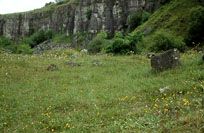 These are often good habitats for many species, especially if there is some cover, and there are many cracks and fissures. Loose rocks and screes provide shelter for many species in most habitats. Specialists in this habitat (browsing mosses, lichens and algae on the surface) are perhaps especially vulnerable to airborne pollution.
These are often good habitats for many species, especially if there is some cover, and there are many cracks and fissures. Loose rocks and screes provide shelter for many species in most habitats. Specialists in this habitat (browsing mosses, lichens and algae on the surface) are perhaps especially vulnerable to airborne pollution.
Associated species
- Abida secale secale - Occasional; has a very patchy geographical spread.
- Balea perversa - Occasional
- Clausilia dubia dubia - Only on limestone in the north of England.
- Helicigona lapicida lapicida - Occasional; occurs in woods without rocks, but is especially common in some northern limestone areas in / on cliffs, screes, quarries and drystone walls.
- Lauria cylindracea - Common; not restricted to rocks, but often especially abundant there, and on walls.
- Lauria sempronii - Very rare.
- Pyramidula pusilla - Occasional; more or less restricted to exposed calcareous rock. Has been found on old ruins and drystone walls.
- Vertigo alpestris - Rare;especially in partly covered drystone walls. Mainly in NW.
- Vertigo pusilla - Occasional; also often in walls, especially in woods or on woodland edge
